“Goin’ Where The Southern Cross The Dog” appears as a lyric in W.C. Handy’s composition Yellow Dog Blues, which he copyrighted in 1914. It refers to the junction of the of two rail lines, the Southern R.R. and the Yazoo Delta R.R. (later part of the Illinois Central) in Moorhead, Mississippi. Here is the origin of the W.C. Handy’s well known song, Yellow Dog Blues, and its equally well known lyric.
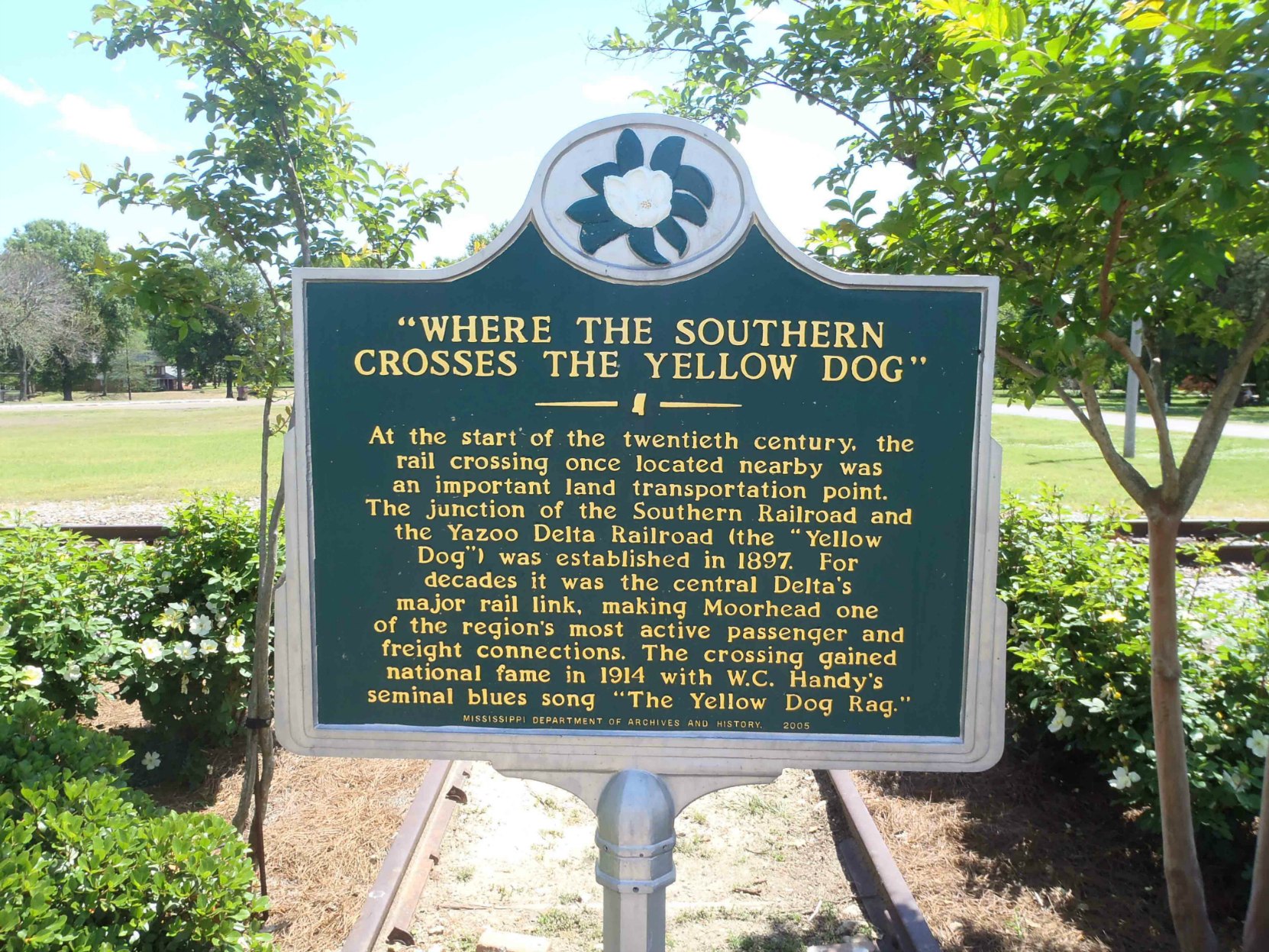
Here’s a clip of Bessie Smith’s 1925 recording of Yellow Dog Blues, with Fletcher Henderson (piano), Coleman Hawkins (tenor sax), Joe Smith (cornet), Charlie Green (trombone) and Buster Bailey (clarinet).
The Yazoo Delta RR was nicknamed the “Yellow Dog.” The Ruleville Depot National Historic Register designation says this nickname came about because the Yazoo Delta RR’s s locomotives and rolling stock were constantly covered in yellow dust from the surrounding agricultural areas and because of the trains’ habit of regularly jumping jumping the tracks.
W.C Handy gives a different explanation for the origin of the nickname “Yellow Dog” in Chapter 6 of his autobiography.
In W.C. Handy’s version, a “blistering sun beats down upon a gang of black section hands during the late nineties [note: construction of the the Yazoo Delta Railroad began in 1897]. They are working down in Mississippi, laying the railroad tracks for the Yazoo Delta line between Clarksdale and Yazoo City. Their hammers rise and fall rhythmically as they drive the heavy spikes and sing ‘Dis ole hammer killed John Henry, won’t kill me. Dis ole hammer killed John Henry, won’t kill me.’
A locomotive, following the progress of the men, is steaming idly on the track. The letters ‘Y.D.’ are painted boldy on its coal car.
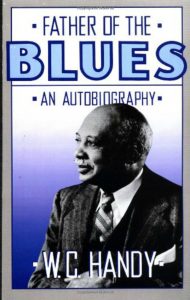
A travelling salesman comes up the embankment, mops the sweat from his face, shifts a chaw of tobacco from one bulging red cheek to the other, and says:
‘Hey, boy. What in tarnation does that Y.D. stand for?’
A Negro straightens up, rubs the kink out of his back and begins to scratch his head in obvious puzzlement.
‘H’m,’ he ventures slowly. ‘Yaller Dawg, I reckon.’
The strangers eyes twinkle. He cackles softly and walks on down the track. ‘Yaller Dawg,’ he repeats under his breath. ‘that’s pretty cute, hanged if it ain’t. Yaller Dawg. Gee whiz, that’s a good one.’ The Yazoo Delta R.R. was christened The Yellow Dog.
The story was circulated and the idea spread until one branch of of the Yazoo Delta was known as the North Dog. For reasons equally suggestive, the fast, direct train from Clarksdale to Greenville was known as the Cannon Ball, while its slow-time, round-about companion between those points was called the Peavine. Negroes had nicknamed all those roads.”
Whatever the source of the Yazoo Delta Railroad’s nickname of the “Yellow Dog,” W.C. Handy used the name in his composition Yellow Dog Blues, which he copyrighted in 1914 and which featured the lyric, “I’m Going Where The Southern Cross The Dog“, referring to the rail intersection of Southern Railway with the “Yellow Dog” in Moorhead, Missisippi.
The name “Yellow Dog” also figures in W.C. Handy’s story of his first hearing the blues in about 1903-04 at the railway station in Tutwiler, Mississippi.
For blues historians, Tutwiler, Mississippi is probably best known as the place where W.C. Handy first discovered the blues, likely around 1903-1904, as he was waiting at Tutwiler’s railway station for a delayed train. At that time, Handy was managing a band based in Clarksdale, Mississippi. The photo below shows the site of the Tutwiler, Mississippi train station as it appears today. The train station has been demolished but the concrete pad on the left of the photograph is what remains of the foundation and floor of the Tutwiler train station.
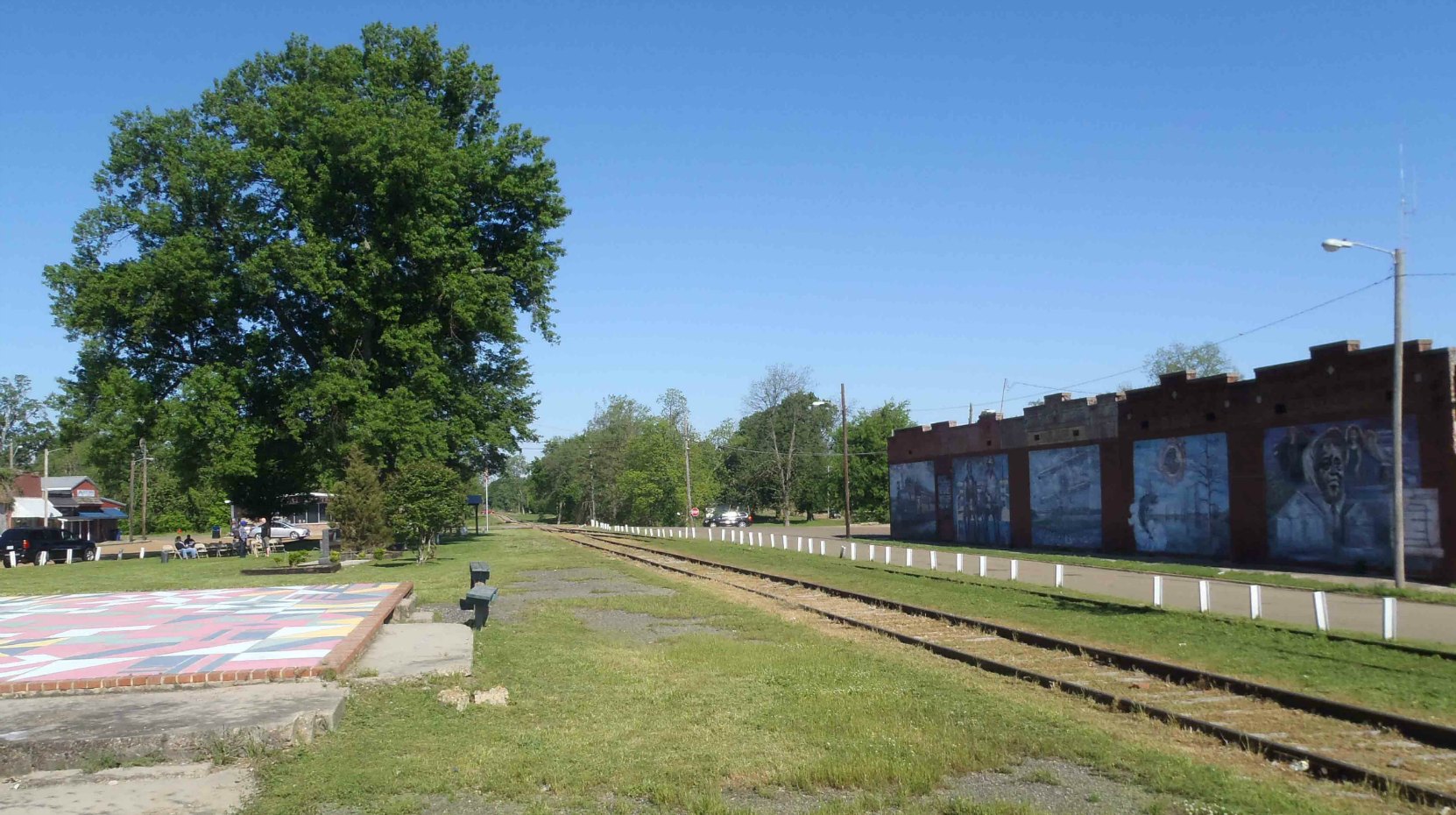
Here’s how W.C. Handy described it in his autobiography
“The band which I found in Clarksdale and the nine-man orchestra which grew out of it did yeoman duty in the Delta. We played for affairs of every description. I came to know by heart every foot of the Delta, even from Clarksdale to Lambert on the Dog and Yazoo City. I could call every stop, water tower and pig path on the Peavine with my eyes closed. It all became a familiar, monotonous round. Then one night in Tutwiler, as I nodded in the railroad station while waiting for a train that had been delayed nine hours, life suddenly took me by the shoulder and wakened me with a start.
A lean, loose-jointed Negro had commenced plunking a guitar beside me while I slept. His clothes were rags, his feet peeped out of his shoes. As he played he pressed a knife on the strings of the guitar in a manner popularized by Hawaiian guitarists who use steel bars. [note: to see what W.C. Handy was describing, watch this video of Bukka White playing Poor Boy in the early 1960s]
The effect was unforgettable. His song, too, struck me instantly. Goin’ where the Southern cross’ the Dog.
The singer repeated the line three times, accompanying himself on the guitar with the weirdest music I had ever heard. The tune stayed in my mind. When the singer paused, I leaned over and asked him what the words meant. He rolled his eyes, showing a trace of mild amusement. Perhaps I should have known, but he didn’t mind explaining. At Moorhead the eastbound and the westbound met and crossed the north and southbound trains four times a day. This fellow was going where the Southern cross’ the Dog, and he didn’t care who knew it. He was simply singing about Moorhead as he waited.
That was not unusual. Southern Negroes sang about everything. Trains, steamboats, steam whistles, sledge hammers, fast women, mean bosses, stubborn mules – all become subjects for their songs.They accompany themselves on anything from which they can extract a musical sound or rhythmical effect, anything from a harmonica to a washboard.
In this way, and from these materials, they set the mood for what we now call blues…….”
This chance encounter at Tutwiler’s railway station sparked W.C. Handy’s interest in the blues. He became aware of the commercial potential of the blues during a performance in Cleveland, Mississippi circa 1905. The Mississippi Blues Trail has commemorated that event with its Enlightenment of W.C. Handy marker in Cleveland.
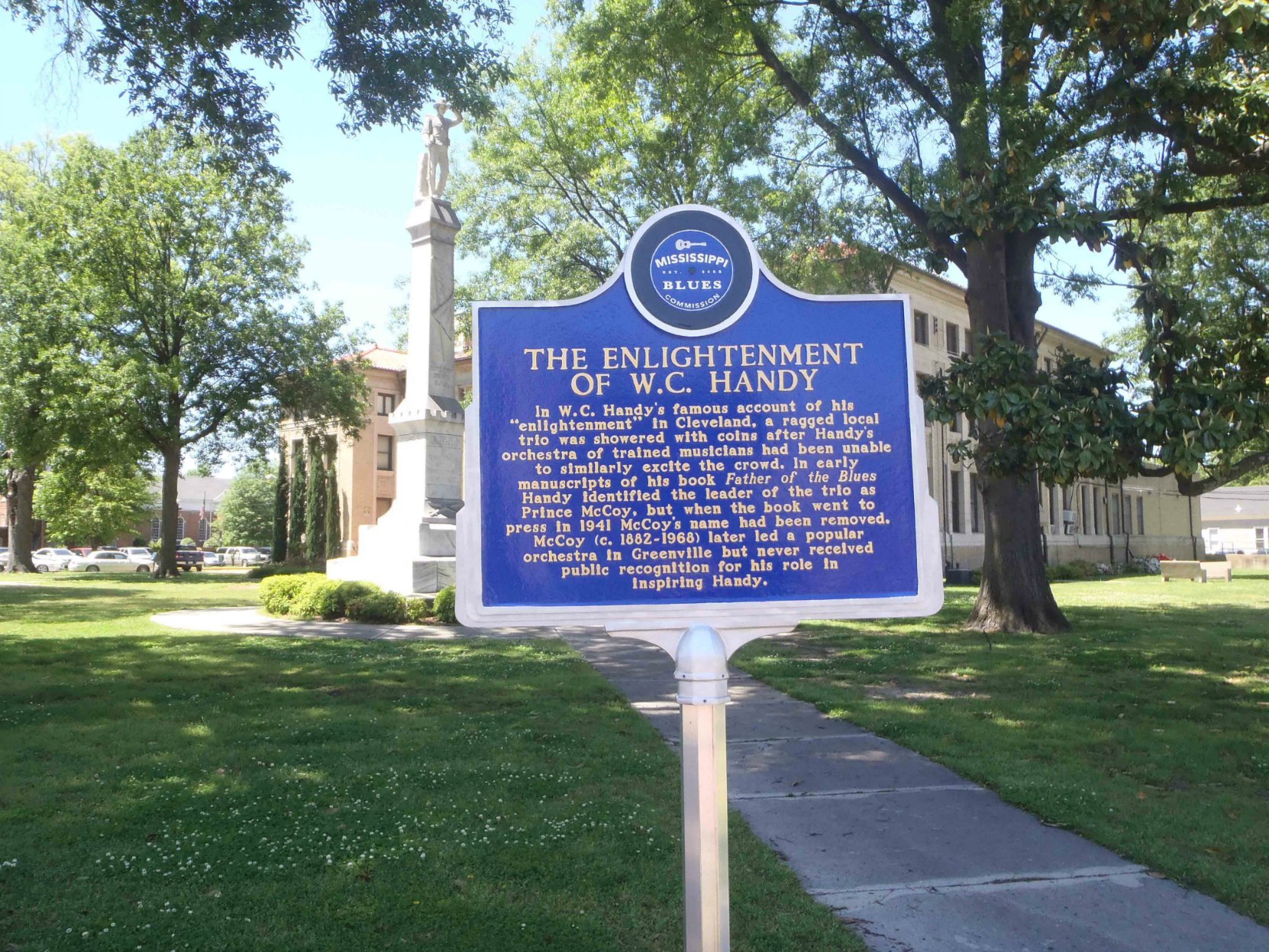
After these encounters in Tutwiler, Mississippi and in Cleveland, Mississippi, W.C. Handy changed his own musical direction to a course which led to his becoming one of the most influential figures in the history of American music.
The photo below shows the Mississippi Blues Trail marker in Tutwiler, Mississippi commemorating W.C. Handy’s first encounter with the blues. It stands near the remains of Tutwiler’s former train station.
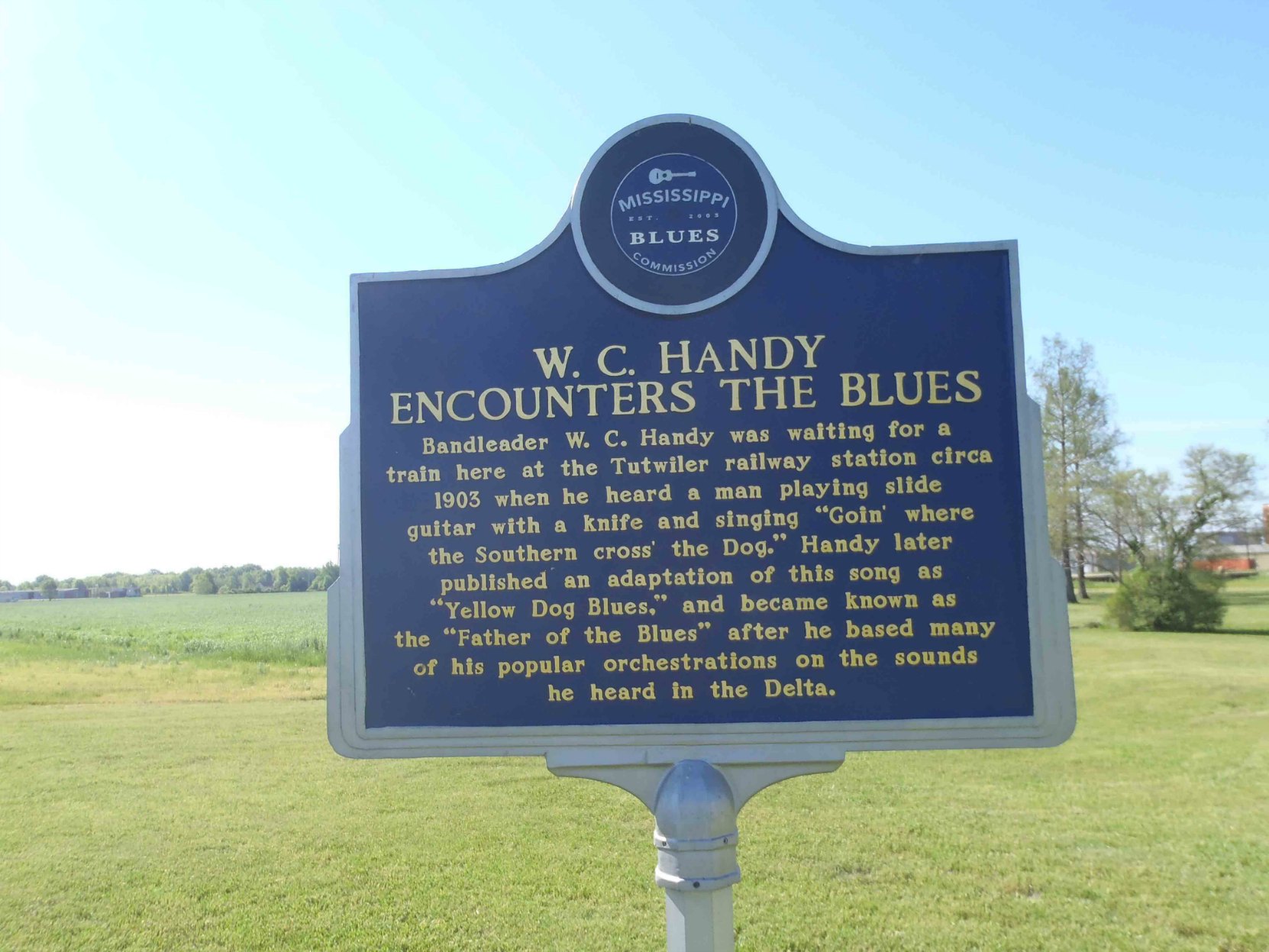
The inscription reads:
“W.C. HANDY ENCOUNTERS THE BLUES
Bandleader W.C. Handy was waiting for a train here at the Tutwiler railway station circa 1903 when he heard a man playing slide guitar with a knife and singing ‘Goin’ where the Southern cross’ the Dog.’ Handy later published an adaptation of this song as ‘Yellow Dog Blues,’ and became known as the ‘father of the Blues’ after he based many of his popular orchestrations on the sounds he heard in Tutwiler.”
The GPS location of this Mississippi Blues Trail marker in Tutwiler, Mississippi is: N34° 00.875′ W90° 25.919′
The photos below shows the actual location “where the Southern cross’ the Dog” in Moorhead, Mississippi. This photo shows the view looking north, the second photo shows the view looking south.
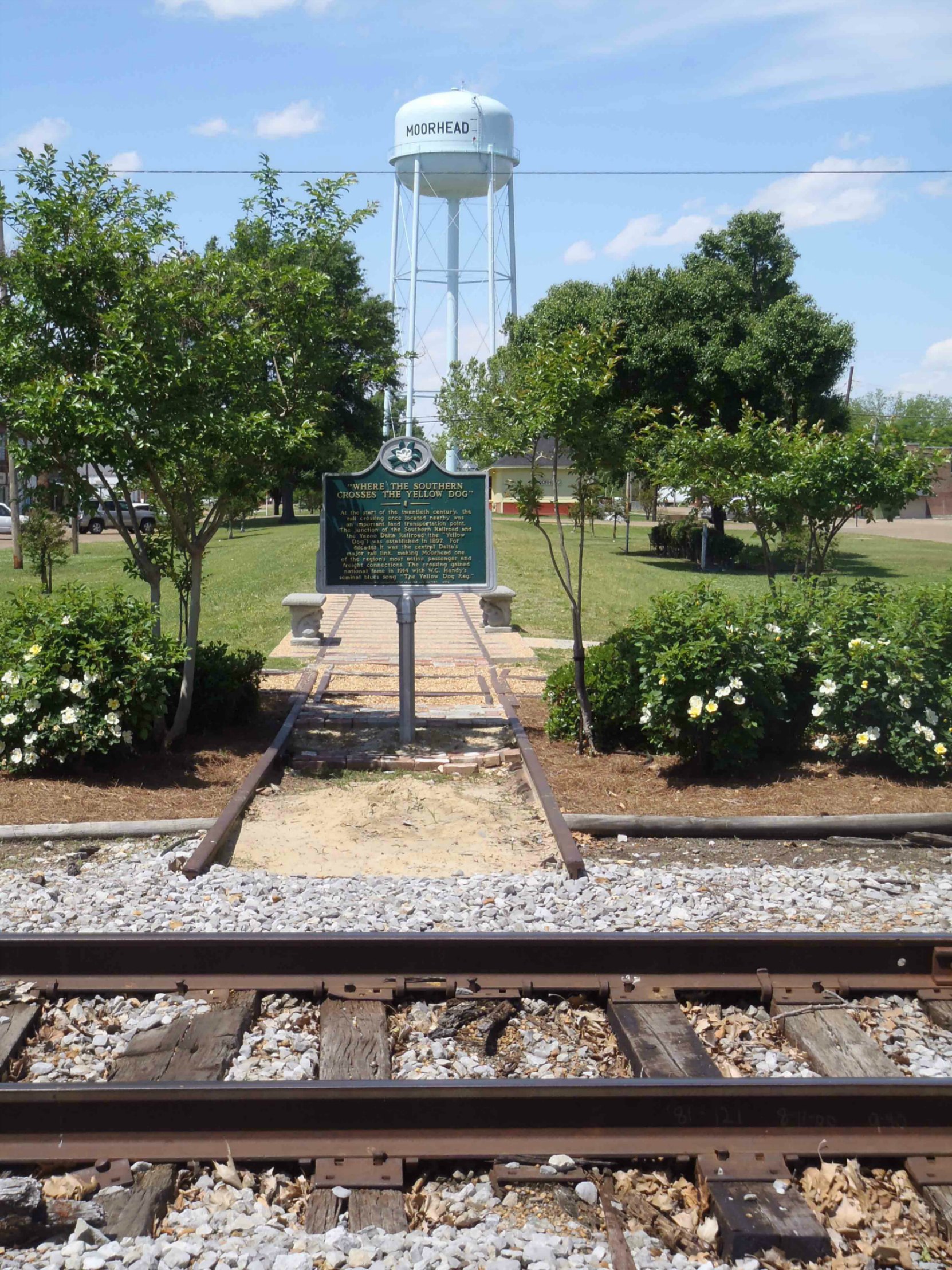
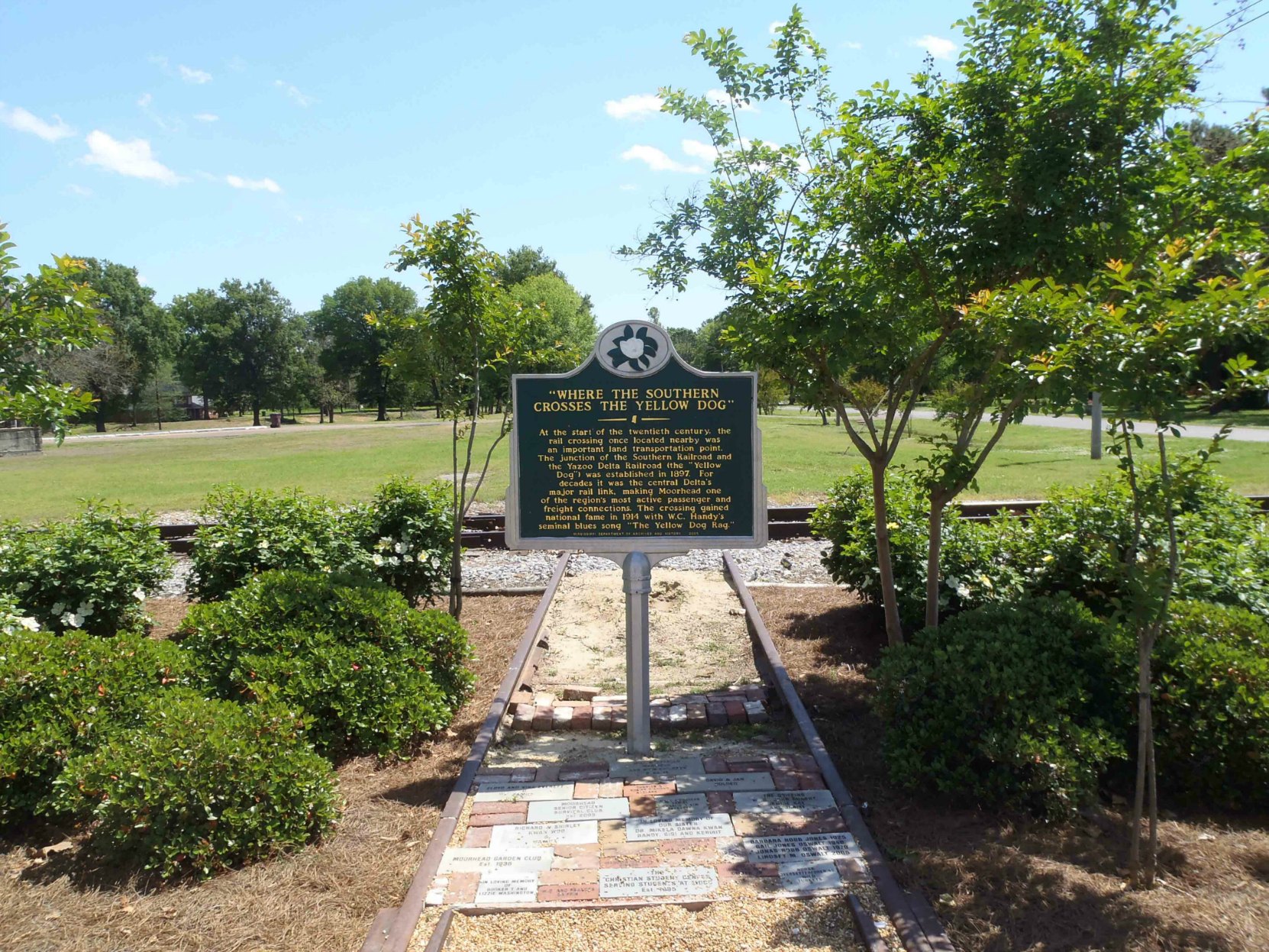
A Mississippi Department of Archives & History marker (shown in the photos above) has been placed at the location where the rail lines intersected. Given the significance of this location in Blues history as a result of W.C. Handy’s Yellow Dog Blues, we were surprised to find that there was no Mississippi Blues Trail marker in Moorhead to commemorate “where the Southern cross’ the Dog.” The Mississippi Blues Trail has since erected a marker in Moorhead.
The GPS location of the Mississippi Department of Archives & History marker for “where the Southern Crosses the Yellow Dog” in Moorhead, Mississippi is: N33° 26.951′ W90° 30.414′
The GPS location of the actual spot “where the Southern cross’ the Dog” is: N33° 26.952′ W90° 30.415′

The Mississippi Department of Archives & History marker reads:
” ‘WHERE THE SOUTHERN CROSSES THE YELLOW DOG‘
At the start of the twentieth century, the rail crossing once located nearby was an important land transportation point. The junction of the Southern Railroad and the Yazoo Delta Railroad (the ‘Yellow Dog’) was established in 1897. For decades it was the Delta’s major rail link, making Moorhead one of the region’s most active passenger and freight connections. The crossing gained national fame in 1914 with W.C. Handy’s seminal blues song ‘The Yellow Dog Blues.’ ”
Other blues songs mentioning the Yellow Dog or this specific location in Moorhead include:
- The Southern Blues by Big Bill Broonzy
- Green River Blues by Charley Patton
- Pay Roll Blues by Lucille Bogan
- Yellow Dog Blues by Sam Collins
Removal of the Railroad Tracks In Moorhead, Mississippi
The rail tracks were removed when the railways shut down these lines in the late 1970’s. When the tracks were taken up, the railroads had no plans to leave tracks in place to mark “where the Southern cross the Dog.” The railroads wanted to remove all the rails and scrap them. They eventually relented when Moorhead residents demanded that rail tracks be left in place to mark this important location in Blues history.
While we were in Moorhead, Mississippi we met a lifelong resident of the town named Gail Oswalt, who told us that her late husband, Steve Oswalt, had been Mayor of Moorhead between 1973 and 1993 and was Moorhead’s Mayor when the railways took up the rail tracks through Moorhead after the rail lines were closed in the late 1970s. She told us her late husband “threw a fit” when he heard of the railroad’s plans to remove all the rail tracks from Moorhead and scrap them. Mayor Oswalt asked the railway to leave the rail tracks in place in Moorhead to commemorate the importance of this rail intersection in American music history but the railway management strongly resisted this request. Gail said her late husband, along with the Moorhead Town Council and local residents, fought a very time consuming battle to get the railway management to leave some of the tracks in place in Moorhead. As a result of their actions, a short section of track was replaced at the former rail intersection to commemorate “where the Southern cross’ the Dog.”
Local residents told us that this house (shown below) near the southwest corner of the former rail intersection in Moorhead, Mississippi was the home of Chester Pond, who built the Yazoo Delta R.R. in 1897. They also told us that Chester Ponds was instrumental in developing the town of Moorhead.
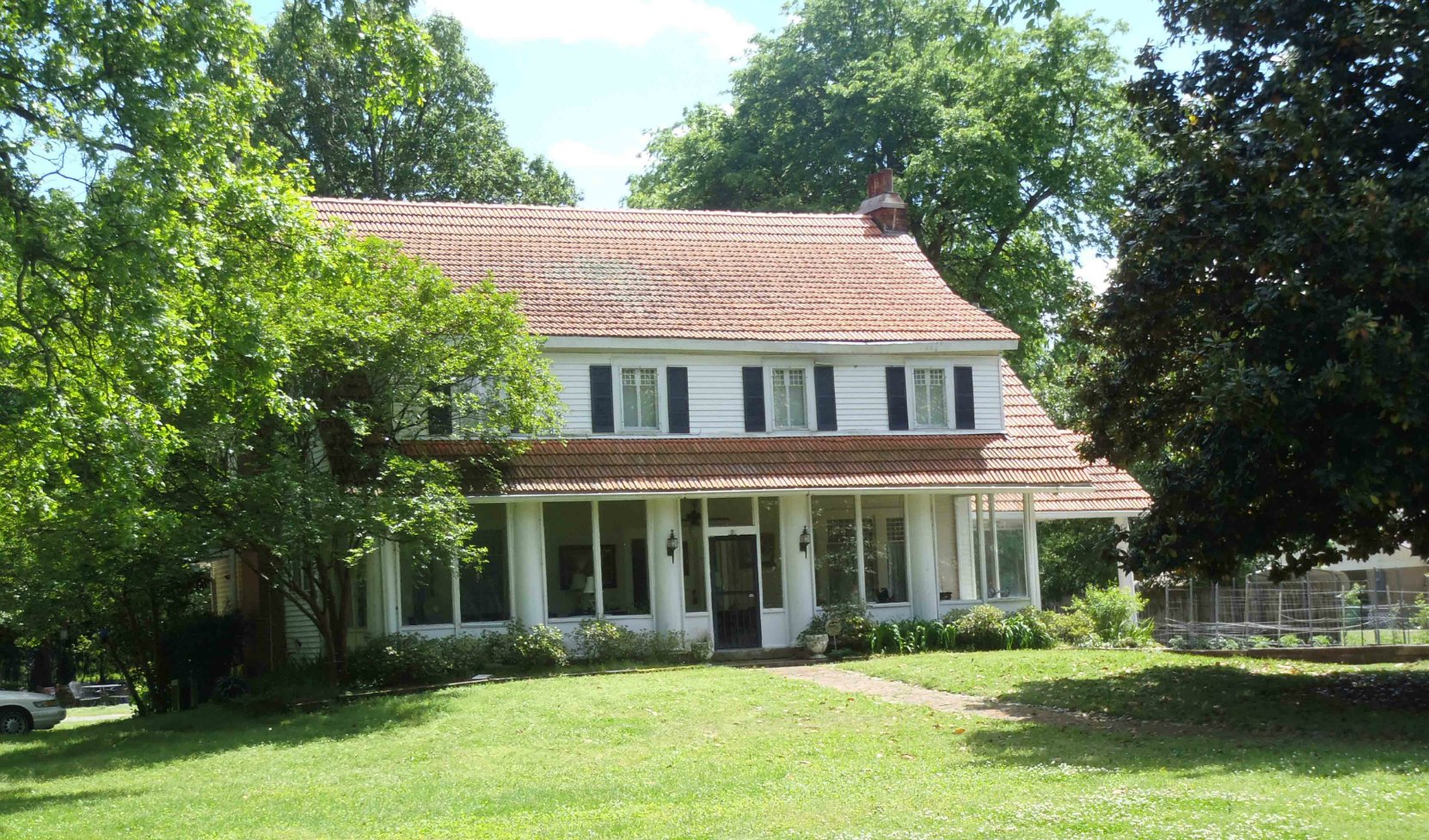
Would you like to leave a comment or question about anything on this page?
The reason for them calling it the Yellow Dog had nothing to do with dust. I will publish an article soon that reveals the true origins of the term in history and the clearing and opening of the Delta. I will chronicle the entire history of the term, the railroad line, and the myths–such as the “dust myth” above–that serve as cover for the truth of its origins in the African American communities in the Delta.
Good luck with your Frank Stokes Benefit on June 24th. It will be good to finally see a grave marker on Frank Stokes’ grave in Hollywood Cemetery in Memphis.
Thanks for this important info. I grew up in Wash. D.C. in the 40s and 50s, and on our piano was sheet music for the Yellow Dog Blues. I learned to play it, at least the chorus. When I learned there is a Yellow Dog river in South Carolina and I knew the Southern R.R. also ran in S .C., I came to believe that that’s what the song meant (where the R.R. crossed the river, somewhere in S.C.). Now, at the age of 83, living in AZ for the last 24 years, I have learned the truth. So thank you for that. My wife is from S.C. (Beaufort) and I’ve been thinking for years that on a trip back there, I am going to find that place. Now I know I will have to travel to Miss. to see it. I am glad it is memorialized in sign and that there are tracks still on the ground where the Southern cross the Yellow Dog.
You’re very welcome. Glad you found the post informative and to set you on the right track on this.
Sound interesting. Be sure to send us a link to your article when you post it.
That was not Chester Pond’s home. This was his youngest daughter’s & her husband’s home.
Thanks for the comment. WE will look into that.
When we were in Moorhead a life long resident told us it had been Chester Pond’s home. That was where we got that information.
It was his daughter Alice and her husband Milton Cooper Smith’s home. Chester’s home was to the right. I can send you a picture of his home if I could request your email.